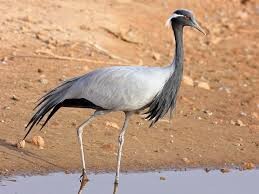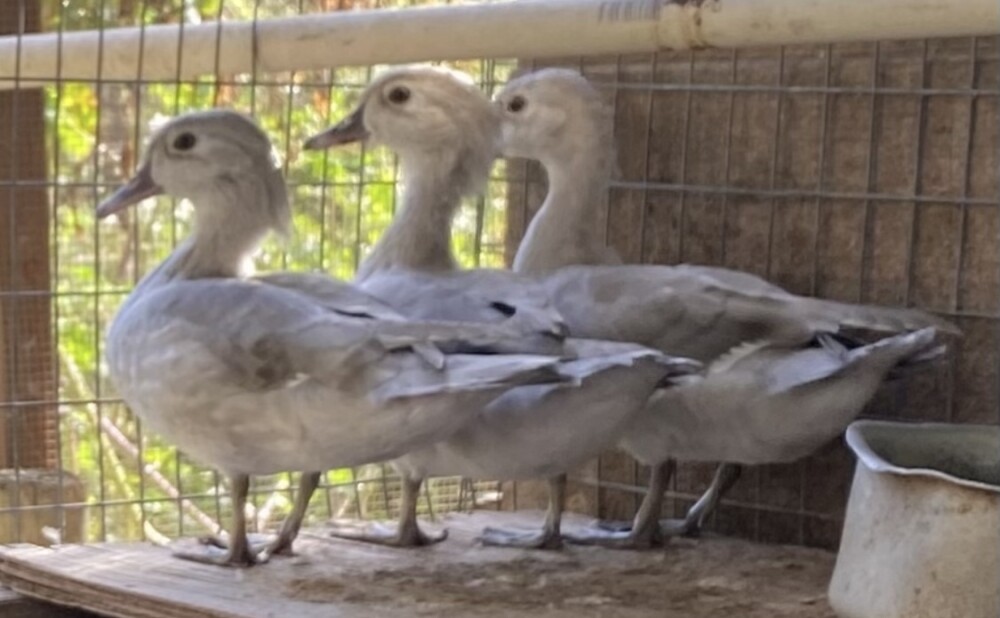Cranes for Sale
Cranes are big and tall, water wading birds of the Gruidae family. They resemble Herons, but are larger and have other small distinctions such as its heavy bill, compact plumage, and elevated hind toe. Like you'd imagine a stork flying, a Crane in flight keeps its head stretched out in front and its legs trail behind. Cranes are an ancient bird with a rich history, often being found in the form of fossils. Its population is alive and well today, being found in nearly every continent except South America, but many of its populations are in danger due to hunting popularity, habitat destruction, and development. Some Cranes migrate to warmer climates in the winter, while those who live in warmer climates don't migrate at all.
East African Crowned Crane
- Name: Shirley Johnson
- Posted: 12/05/2025
- Phone: 7034330002
- Email: Email Seller
- Location: Virginia
- Website: www.leesburganimalpark.com
2025 hatch. DNA sexed. 2 females and 1 male

Demoiselle Cranes 2025 Hatch
- Name: Kurt
- Posted: 11/10/2025
- Email: Email Seller
- Location: North Carolina
These are (3) DNA'ed male Demoiselle Cranes 2025 Hatch They are well socialized to humans and very easy to work around. They are full winged to promote their ability to balance on hens for fertilization purposes so no infertile eggs. They ar...
Demosielle Cranes
- Name: Karl
- Posted: 11/05/2025
- Phone: 540 460 7158
- Location: Virginia
3 - Demosielle Cranes, 2025 Hatch . All DNA Sexed males.

Waterfowl, Java greens, Crane
- Name: Kenny in Florida 32433
- Posted: 10/10/2025
- Phone: 8505201319
- Email: Email Seller
- Location: Florida
I have available to fly to a new coop the following. 6- 2025 unsexed Black Belly Tree Ducks, full wing, properly marked with proper paperwork 3-186 ownership forms. 1- pair of 2025 Synhoe pheasant 6- 2025 unsexed American Java Green Peachicks...

Crowned Crane Male
- Price: $1,250.00
- Name: Eric
- Posted: 06/28/2025
- Email: Email Seller
- Location: Oregon
Have a mature male crown crane, looking for a mate… Looking to find aviary for him So he won’t be by himself! Asking 1250 pick up only in Oregon. Might be able to meet halfway for the right situation. He is missing a couple of toenails due to frostbi...

Demoiselle Crane - Male
- Price: $1,200.00
- Name: Andrea Cabibi
- Posted: 06/23/2025
- Email: Email Seller
- Location: California
Demoiselle crane. DNA sexed male. Available soon, or to experienced chick rearing home. Date of hatch June 4, 2025. Hand raised, very tame. Perfect legs and toes. Very healthy.
Types of Cranes for Sale
- Demoiselle Crane for Sale
- East African Crowned Crane for Sale
- Sandhill Crane for Sale
- Sarus Crane for Sale
- Stanley Crane for Sale
Cranes In Nature
Living in marshes and wetter lands, Cranes typically stalk small animal prey of all sorts and eat grains and grasses as well, but they are opportunistic feeders and will change their diet depending on the season, their nutrient requirements, and the region in which they live. Knowing this information, a Crane might also eat fish, amphibians, insects, berries, and plants. This trait of adaptability is often the reason a bird species have survived so long.
Behavior
Crane behavior changes based on the season. During breeding season, they are territorial like most birds and usually remain on their nesting grounds all the time. During seasons not dedicated to bringing young into the world, Cranes form large flocks, roost together, socialize, and feed together. During this season, strength in numbers keeps the birds safe and also offers single birds the opportunity to find a mate.
Science has shown us that Cranes have a very large vocabulary of which they are able to communicate with. Their communication begins just after birth when they use low, purring sounds to keep in contact with nearby parents. They also have a call for food begging. Then they will learn to use alarm calls and calls that announce a flight. Both are maintained and useful in their adult Crane lives. Cranes also call in “duets” and have calls that make distinctions between one bird and the next!
Reproduction
Most Crane species have elaborate and loud courting displays or “dances” to win over a potential mate. Once bonded, two Cranes will be together for the length of their lives, especially if they were successful at breeding together. In a study of Sandhill Cranes specifically, 7 of 22 pairs stayed together for an 11-year period. Of the ones who did not separate, 53% separated due to death, 18% due to “Crane Divorce”, and 29% of the pair's fates were recorded as unknown.
Cranes build platform nests in shallow water. Of the 15 species, only two roosts in trees: the two African crowned cranes species. The average clutch is two eggs. Both males and females share the parenting responsibilities. Cranes are social and live in flocks except during breeding season.
Cranes perform elaborate courtship dances. They face each and perform ritualistic display behaviors like head bobbing or turning their backs on their partners. Then, they suddenly leap into the air. They dance, they call to each, they throw sticks. The urge to dance is so strong in this species even young chicks can be seen trying to leap or perform some of the ritual behaviors.
Cranes lay two grayish, brown spotted eggs in a nest of grasses on dry ground and they oftentimes use the same nest year after year. Upon hatching, young Crane can run! The two Cranes and their young will stay together until the next mating season before their two become independent.
Bird Species and Endangerment Status'
Some prominent types of Cranes are the Common Crane of Europe and Northern Asia, the Australian Crane, the Demoiselle Crane, the Crowned Crane, and the Wattled Crane. Cranes all over the world face the danger of lowering populations due to hunting and the loss of important wetlands. The Sandhill Crane is typical to the United States, but once bred in Canada. It has become increasingly rare in recent years and it's patterns like these that can tell us what is going on with the various species of Crane and make efforts to protect their kind. Many Sandhills are now classified as rare or endangered in their regions.
Did You Know Cranes Can Dance?
Cranes are beautiful, graceful water fowl best known for their elaborate dances. From largest to tallest to smallest, this is a fascinating species, and a real favorite with bird watchers or bird enthusiasts.
Cranes have long legs and necks, rounded wings and streamlined bodies. Many of the species are sexually dimorphic (sexes look alike). Males are usually larger than the females are. Unlike their voiceless relatives the storks, they are vocal. They use their vocalizations recognize specific individuals and communicate.
Cranes are members of the Gruidae family and the Gruiformes group. Fifteen species are found in their family tree. Many of these birds have a conservation status of either threatened or endangered. Sandhill cranes are the largest population group. Whooping cranes are the rarest members.
Cranes Diet
Antarctica and South America are the only two continents on which cranes are not found. Some cranes are migratory; some are not. Their typical diet is dictated by seasonal changes or their nutritional needs. However, in general, they are omnivorous and consume a wide variety of animal and plant foods such as:
- Rodents (mice, rats, squirrels)
- Fish
- Amphibians (frogs, newts, toads)
- Crustaceans
- Insects
- Grains like rice and corm
- Berries and aquatic plants
Cranes are diurnal, which means they feed during the day.
Mistaken Identities
Cranes are often mistaken for other species to which they bear a resemblance. For instance, cranes are often erroneously identified as herons or egrets. Observing the shape of their necks is an effortless way to identify them. Herons and egrets have curved necks that form an “S” shape. On cranes, the necks are shorter and held straight. They belong to different family orders.
Likewise, storks and cranes are sometimes misidentified. Since both fly with outstretched necks, it’s easy to confuse them. Additionally, they have similar appearances.
Smallest and Tallest Cranes
The smallest member of the crane family is the demoiselle crane (Grus crane). Its range covers Central Eurasia from the Black Sea to north eastern China. They are a migratory species.
The average length of a Demoiselle crane is around 33 to 40 inches with an average 61 to 71-inch wingspan. They are about 2.5 feet tall and weigh around four to seven pounds.
Tallest
At the other end of the scale, the Sarus crane (Grus antigone) is indisputably the tallest flying bird in the world. This species is non-migratory and includes three territorial population groups:
- Indian Sarus cranes
- Eastern Sarus cranes
- Australian Sarus cranes
Tipping the scales at about 11 to 26 pounds and measuring about 5’9”, this is a gigantic bird with an impressive wingspan of around 87 to 99 inches. The body, crown, and wings are grey. The neck and head, which is bald, are bright red, while the legs are a lighter, almost pink shade.
Whooping Cranes
While not the smallest or the tallest family members, Whooping cranes are recognized as the tallest North American birds. Over five feet tall, with a gigantic wingspan of over seven feet, they are a remarkable sight both on land and in the air.
The coloration of these lofty birds is unique and rare. They are one of three other crane species that are mostly white. The plight the whooping crane was the impetus behind some of the first protective species legislation in the U.S. As you might guess, they derive their name because their cries sound like a whoop.
They are migratory birds and like most other cranes, they live in family groups except during mating season. These endangered waterfowl are often mistaken for Sandhill cranes because they look similar, especially in flight. The tragedy of their look-alike resemblance is they are sometimes killed by hunters who thought they were Sandhill cranes.
What makes cranes so special? In addition to their majestic dances, their fossils point to their roots to the ancient world. Many cultures hold cranes in high esteem. In fact, the Japanese consider them to be national treasures. In Chinese and Japanese cultures, cranes are revered as symbols of longevity, auspiciousness, and fidelity. These are just a few of the many reasons why people are fascinated with cranes.

Comments